Mosquitoes? Plant carnivorous plants in your garden.

They call themselves Skippy, a strangely cheerful name for a group devoted to a fairly creepy endeavor (at least from this animal’s perspective) — the care and breeding of carnivorous plants.
Yes, we’re talking about plants that prey on living creatures — insects mostly, but in some far-off jungles even small mammals and birds. (In Borneo, one pitcher plant — Nepenthes rajah — has even evolved to sup on the droppings of shrews.)
It’s a little gruesome, “but that’s exactly why people love them so well,” said John Kim, president and co-founder of SCCPE (a.k.a. Skippy) — the Southern California Carnivorous Plant Enthusiasts, which is having its second-ever show and sale June 18-19 at Sherman Library & Gardens, 2647 E. Coast Highway, Corona del Mar, from 10:30 a.m. to 4 p.m. each day. The show is free with $5 admission to the gardens (members and children 3 and younger enter free).
“Half the people will tell you they love the carnivory — turning the table on nature to where the plants eat the bugs — but others will tell you they love the variety,” Kim said. “The general public thinks of Venus flytraps, but that’s just a small percentage of the carnivorous plants that can be found on every continent except the Arctics.”
To call carnivorous plants exotic is an understatement — they grow in extraordinary shapes and colors, with the common thread being they all have an area big enough to hold and digest their prey, whether it’s inside the slippery, tube-shaped bodies of North American pitcher plants or the flat sticky leaves of the succulent-like butterwort.
David Fefferman stands for a portrait holding a North American pitcher plant, a carnivorous plant, at his home nursery.
(Dania Maxwell / Los Angeles Times)
Most plants get their nourishment from the sun and soil, but carnivorous plants have evolved to digest animals, usually hapless bugs fatally attracted to the plants’ sweet, sticky nectar and other deadly wiles, like soft downward pointing hairs that make gliding down the fragrant throat of a pitcher plant a piece of cake (or fly) but climbing out impossible.
David Fefferman, a Skippy member from Mission Viejo and one of California’s largest collectors and breeders of carnivorous plants, agrees that the carnivory is what initially attracts many fans. “But nobody really dwells on the death aspect of it. ‘Carnivorous plant’ is definitely the headline, but once you get involved, you stay for the joy of growing fascinating, beautiful plants.”

David Fefferman holds a Nepenthes rajah x veitchii at his home nursery.
(Dania Maxwell / Los Angeles Times)
But it’s not just that these plants are unusual, Kim said. “They are functional as well. They don’t eat meat exactly. They eat flies, gnats, fruit flies, spiders and mosquitos, so really they’re your friends. Orchid growers will always keep a few around because, with all the wetness and humidity their plants like, they always struggle with pests.”
His pitcher plants are so effective at catching insects, Kim said, “They sometimes overflow at the top! And because North American pitcher plants go dormant in the winter, they kind of fall apart, so all the bugs’ exoskeletons are exposed, where they break down in the soil or just blow away in the wind. Because the plants can’t digest the exoskeletons; they only digest the soft parts of the insects.”
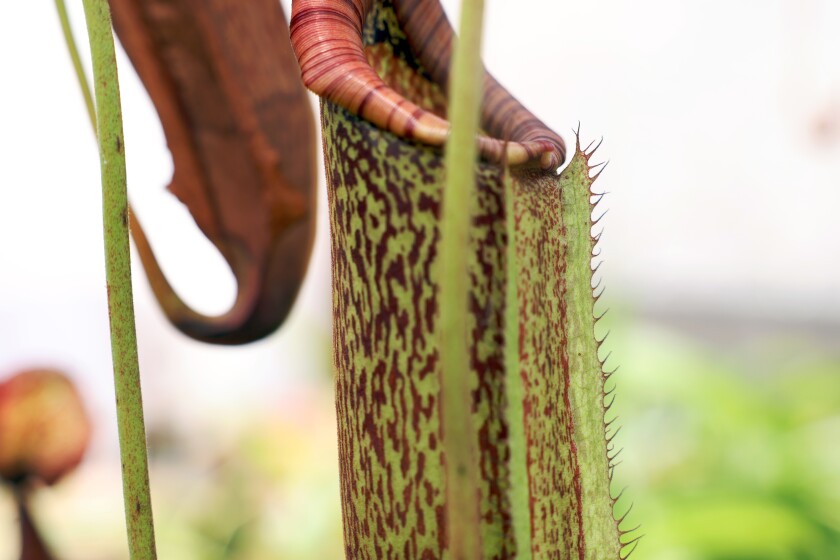
A Nepenthes maxima at David Fefferman’s home nursery.
(Dania Maxwell / Los Angeles Times)
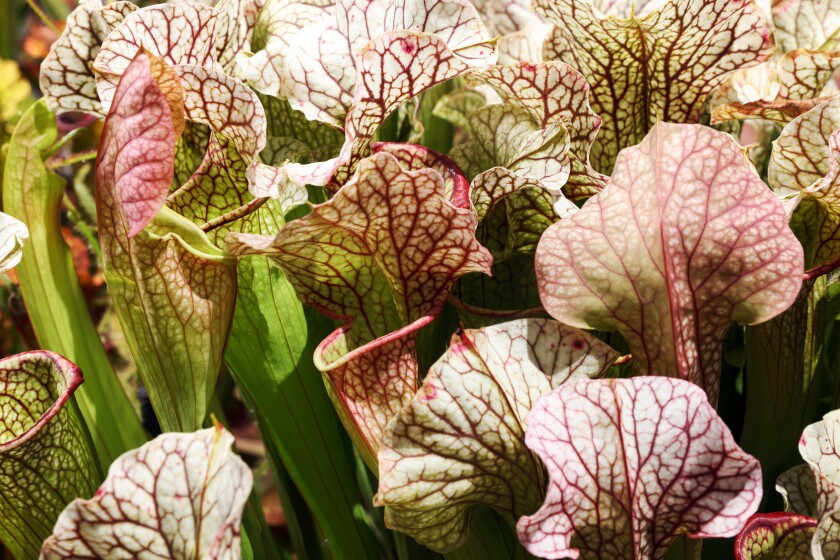
A Sarracenia ‘Stingray’ is photographed at David Fefferman’s home nursery.
(Dania Maxwell / Los Angeles Times)

Sarracenia oreophila x chinooks at David Fefferman’s home nursery.
(Dania Maxwell / Los Angeles Times)
In case you want a more graphic image of this, Kim said the club will be displaying various carnivorous plants cut open so you can see their buggy digestive systems.
Ewwww.
Just to be clear, Kim is not a teenager. He’s married, about to turn 39, and works 60 to 80 hours a week as a construction project manager in Orange County. He has many hobbies, including other plants, and loves joining clubs that cater to his interests. “It’s where I find enjoyment. I don’t watch TV, read books, drink or gamble. My ‘me’ time is being involved with these clubs. I do meeting minutes for fun, I love to listen to lectures, and I have five different copies of ‘Robert’s Rules of Order.’ … I guess the world needs people like me too.”
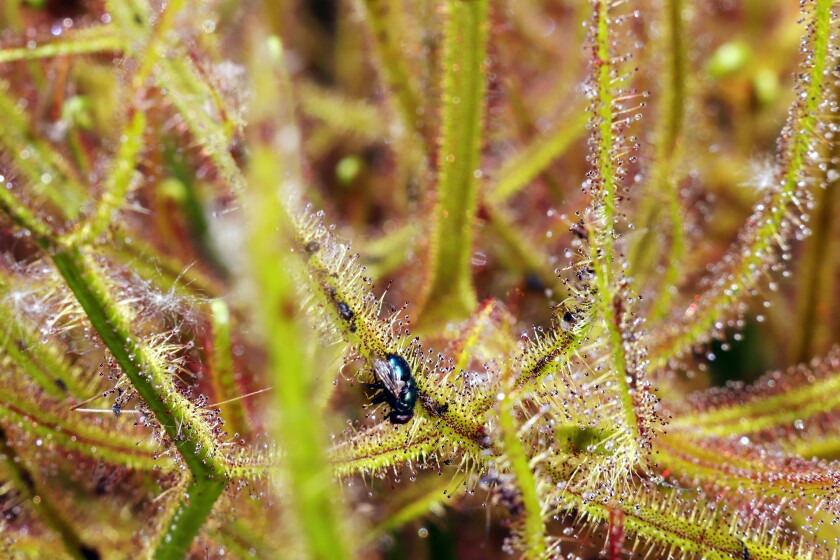
A Drosera binata Dichotoma giant at David Fefferman’s home nursery.
(Dania Maxwell / Los Angeles Times)

A Nepenthes boshiana x adrianii, left, and Nepenthes copelandii x lowii at David Fefferman’s home nursery.
(Dania Maxwell / Los Angeles Times)
His carnivorous plants play big roles in his other passions. He’s adopted a parrot and tortoises, whose droppings draw flies to his yard — and those flies are efficiently consumed by his useful pitcher plants.
Although they look very exotic and temperamental, most carnivorous plants are pretty easy to grow, Kim and Fefferman agreed. Some are happy in a windowsill with bright, indirect light. Others, like the North American pitcher plant, are from the country’s steamy, boggy parts of the southeast, so they prefer to be outdoors in Southern California where they can drink up all our heat.
But you can’t put them in the ground, Fefferman said. He plants his in pots filled with a 60/40 mix of peat moss and perlite because regular potting soil or even regular soil would be too rich and burn the roots. And he keeps a saucer filled with an inch or two of water under all his pots. Most plants will drown if their roots stay too long in water, but pitcher plants evolved in marshes leached of nutrients, said Fefferman, which is why they turned to insects for nourishment.
And because carnivorous plants evolved in depleted soils, they are very sensitive to minerals or fertilizers in their water too, Fefferman said. Our drinking water is full of minerals, so he uses rainwater (when available) or a reverse osmosis system to demineralize his water (the kind found in many under-sink filtration systems). Kim said you can accomplish the same thing by using distilled water, available at drugstores.
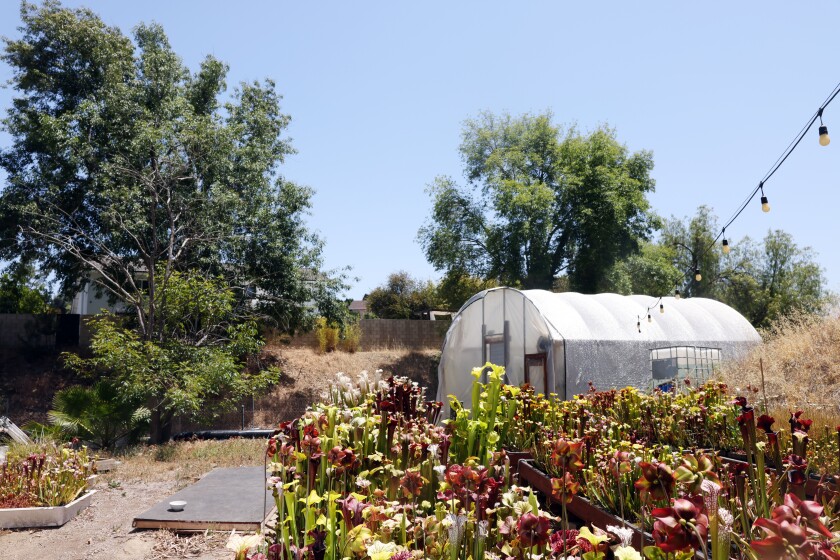
David Fefferman’s home nursery of carnivorous plants.
(Dania Maxwell / Los Angeles Times)
Skippy is a relatively new Orange County-based club — its first meeting was two weeks before the COVID-19 shutdowns in March 2020 — but club members used Zoom to hold monthly meetings during the pandemic and now there are about 100 members. They’re eagerly preparing for their second show and sale on Father’s Day weekend.
If the turnout this year is anything like the first year — which drew more than 1,300 people over two days — you’d better come early and expect a very diverse crowd, said Kim.
“Throughout the weekend we had [Sherman] garden staff telling us they’d never seen so many young people in the garden,” Kim said.
“We had conservatives and goths, just a plethora of people coming to the garden, and it was very noticeable.”
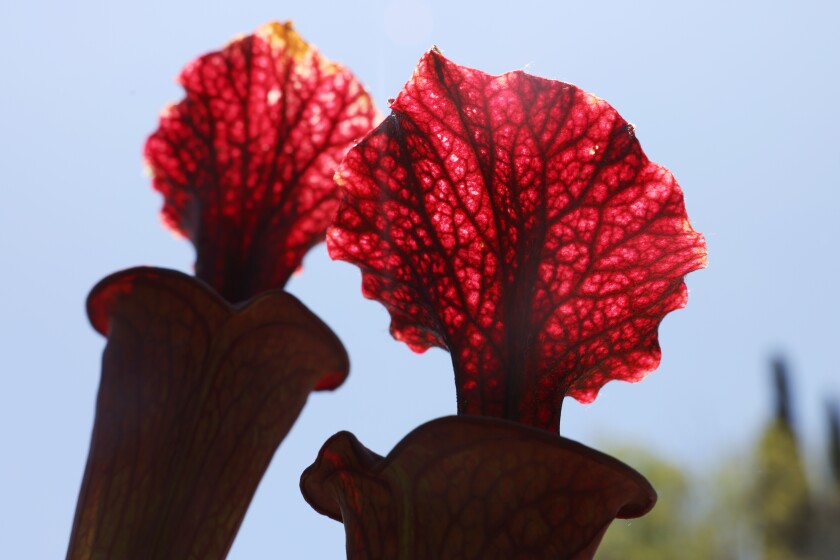
Sarracenia ‘Purple Sparks’ at David Fefferman’s home nursery.
(Dania Maxwell / Los Angeles Times)
Fefferman, a product manager for the tech company Linktree, won some top prizes last year, and he’s excited to show again. He’ll also be among the vendors selling some of his thousands of plants. At some point, Fefferman said he’ll have to consider becoming a nursery, but for now, he just maintains his website, a marketplace for other carnivorous plant vendors called CarnivorousPlantResource.com, where prices range from $5 for seeds to more than $1,000 for rarer plants.
He expects beginners to find a good selection at the show, with prices around $30. And he really wants to emphasize that these plants are spectacular despite their carnivorous ways.
“I don’t like these plants because they kill things,” Fefferman said. “In fact, I’m very much about them not killing things. If I see a honeybee in one, I will fish it out, because bees have enough troubles already. But I love the natural world, and these plants lean into that, because they’re super fascinating and super beautiful.”
If bug-eating plants don’t ring your bell, there are lots of other plant- and garden-related events and activities for June. Email events to [email protected] at least three weeks before they happen, and we might include them in the calendar.
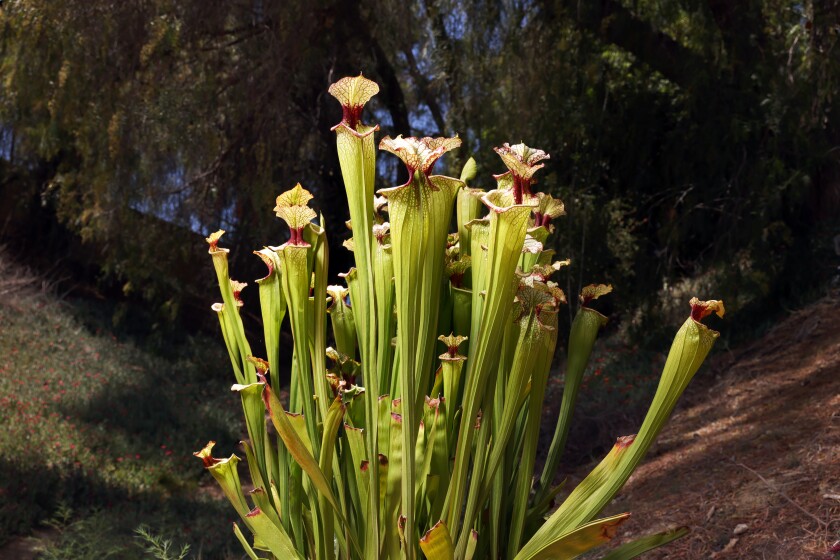
A Sarracena ‘Leah Wilkerson’ at David Fefferman’s home nursery.
(Dania Maxwell / Los Angeles Times)




